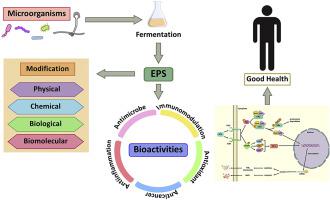Food Bioscience ( IF 5.2 ) Pub Date : 2020-03-09 , DOI: 10.1016/j.fbio.2020.100564 Worraprat Chaisuwan , Kittisak Jantanasakulwong , Sutee Wangtueai , Yuthana Phimolsiripol , Thanongsak Chaiyaso , Charin Techapun , Suphat Phongthai , SangGuan You , Joe M. Regenstein , Phisit Seesuriyachan

|
Many microorganisms are able to synthesize polysaccharides and then secrete them into the external environment; these compounds are known as exopolysaccharides (EPS). The EPS are produced for various purposes including protection, adhesion, biofilm formation, and as a nutrient source. These polymers can be produced by microbes such as archaea, bacteria, and fungi. On an industrial scale, it is beneficial to use microbes because they can be cultivated using controlled conditions and produce a large quantity of EPS within short periods. Fermentation techniques, therefore, are important strategies that are used to improve product yield and productivity. These techniques can be done using submerged fermentation and solid-state fermentation. In addition, the application of optimization techniques are able to be used to obtain the maximum yield of microbial EPS. Some EPS (called bioactive EPS) derived from microbes show bioactivities such as anticancer, antioxidant, antimicrobial, and immunomodulatory activities. There are many factors influencing their bioactivities including their structure, molecular weight, functional groups, and monosaccharide compositions. Moreover, there are many reports where various methods have been used to modify microbial EPS to improve their bioactivities. The modification methods include biological, physical, chemical, and biomolecular modifications. Additionally, immunomodulatory EPS have been extensively studied. The immune stimulating activities of EPS have been investigated both in vitro and in vivo, and some reports have suggested possible pathways for activating the immune response. This review will focus on resources, fermentation, modification, and bioactivities of EPS, and review possible mechanisms of microbial EPS stimulating immune responses.
中文翻译:

用于增强免疫力的微生物胞外多糖:发酵,修饰和生物活性
许多微生物能够合成多糖,然后将其分泌到外部环境中。这些化合物被称为胞外多糖(EPS)。生产EPS的目的多种多样,包括保护,粘附,生物膜形成以及作为营养来源。这些聚合物可以由诸如古细菌,细菌和真菌的微生物产生。在工业规模上,使用微生物是有益的,因为可以在受控条件下进行培养并在短时间内产生大量EPS。因此,发酵技术是用于提高产品产量和生产率的重要策略。这些技术可以使用浸没式发酵和固态发酵来完成。此外,优化技术的应用能够用于获得微生物EPS的最大产量。一些源自微生物的EPS(称为生物活性EPS)具有生物活性,例如抗癌,抗氧化剂,抗微生物和免疫调节活性。有许多因素影响其生物活性,包括它们的结构,分子量,官能团和单糖组成。此外,有许多报道,其中已经使用各种方法来修饰微生物EPS以改善其生物活性。修饰方法包括生物,物理,化学和生物分子修饰。另外,已经广泛研究了免疫调节EPS。都对EPS的免疫刺激活性进行了研究 一些源自微生物的EPS(称为生物活性EPS)具有生物活性,例如抗癌,抗氧化剂,抗微生物和免疫调节活性。有许多因素影响其生物活性,包括它们的结构,分子量,官能团和单糖组成。此外,有许多报道,其中已经使用各种方法来修饰微生物EPS以改善其生物活性。修饰方法包括生物,物理,化学和生物分子修饰。另外,已经广泛研究了免疫调节EPS。都对EPS的免疫刺激活性进行了研究 一些源自微生物的EPS(称为生物活性EPS)具有生物活性,例如抗癌,抗氧化剂,抗微生物和免疫调节活性。有许多因素影响其生物活性,包括它们的结构,分子量,官能团和单糖组成。此外,有许多报道,其中已经使用各种方法来修饰微生物EPS以改善其生物活性。修饰方法包括生物,物理,化学和生物分子修饰。另外,已经广泛研究了免疫调节EPS。都对EPS的免疫刺激活性进行了研究 和单糖成分。此外,有许多报道,其中已经使用各种方法来修饰微生物EPS以改善其生物活性。修饰方法包括生物,物理,化学和生物分子修饰。另外,已经广泛研究了免疫调节EPS。都对EPS的免疫刺激活性进行了研究 和单糖成分。此外,有许多报道,其中已经使用各种方法来修饰微生物EPS以改善其生物活性。修饰方法包括生物,物理,化学和生物分子修饰。另外,已经广泛研究了免疫调节EPS。都对EPS的免疫刺激活性进行了研究在体外和体内,一些报道提出了激活免疫反应的可能途径。这项审查将侧重于EPS的资源,发酵,修饰和生物活性,并审查微生物EPS刺激免疫反应的可能机制。



























 京公网安备 11010802027423号
京公网安备 11010802027423号